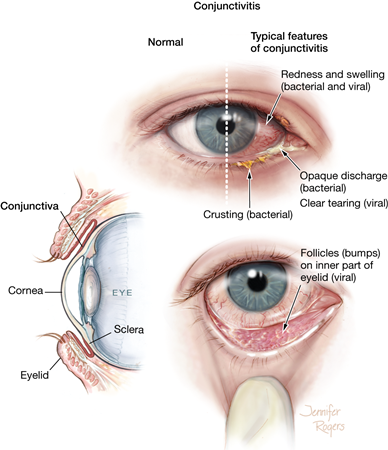Posted 19 October 2017
There are a number of conditions that can cause red eyes,
with conjunctivitis being a common one. Other symptoms include itching,
watering and sometimes stickiness of the eyelashes. The good thing is that in
most cases, it can be controlled without the input of your GP! (1)

What is
conjunctivitis?
Conjunctivitis means inflammation of the conjunctiva, which
is a thin lining on the front of the eye. It can affect one or both eyes. (2)
What is the cause?
There is more than one cause of conjunctivitis, each of
which usually yields different symptoms.
Infective
conjunctivitis is caused by bacteria or a virus. As the name suggests, it
can be caught from and passed on to other people.
Bacterial conjunctivitis tends to produce a yellow pus
that leads to stickiness and crusting of the eyelashes. It is usually spread
when an infected person rubs their eyes, then touches a surface which is
subsequently touched by another person, who can contract the infection if they
then touch their own eyes.
Viral conjunctivitis is often associated with a gritty,
irritated sensation in the eye. It is passed to other people via coughing and
sneezing as well as physical contact, so is the more contagious form. (2,3)
Allergic
conjunctivitis is caused by allergens, usually pollen, dust mites or pet
dander, coming into contact with the eye and inducing a reaction. Symptoms
include itchy, red and watering eyes. It often appears with hayfever or
perennial rhinitis. (2,3)
Irritant
conjunctivitis is caused by foreign objects, such as a detached eyelash or
grit from the outdoors, getting trapped under the eyelid and rubbing against
the eye. It can also be caused by irritating substances such as shampoo or
chlorine-treated water found in swimming baths coming into contact with the
eyes. The eyes should return to normal shortly after the irritant is removed.
(2,3)
How is it treated?
Infective conjunctivitis is generally a self-limiting
condition, meaning it will probably clear up on its own, usually within a
couple of weeks. In the meantime, to ease the symptoms, you can bathe the
affected eye(s) in boiled and cooled water with the aid of cotton wool. If you
have bacterial conjunctivitis and bathing is not sufficient to control the
symptoms, visit your pharmacist who will assess your condition and sell you
antibiotic eye drops (chloramphenicol)
if they see fit. (1,2)
Allergic conjunctivitis can be managed with antihistamines,
either in eye drop form (sodium
cromoglicate) or taken by mouth in tablet or liquid form (such as chlorphenamine or loratadine). Avoiding contact with the allergen is also
recommended, which may involve regular thorough cleaning of your home to
minimise dust, or keeping windows closed where possible when the pollen count
is high. (2)
When to see your GP
Despite most conjunctivitis cases being easily managed
through self care or the pharmacy, there are instances where you will need to
visit your GP. Pain in the eye, changes in vision, sensitivity to light or
intensely red eyes all warrant an urgent GP appointment. Additionally, if you
have a child under the age of two years, you will need to take them to their
GP. (2)
Reducing the spread
of infective conjunctivitis
If you are suffering with bacterial or viral conjunctivitis,
be sure to wash your hands frequently and avoid touching your eyes. Do not
share pillows or towels.
You should be fine to go to work or school unless your
symptoms are severe and you don’t feel well enough to attend. However, if your
job involves close contact with people, or use of shared phones or computers,
it is advised that you stay at home until your symptoms have resolved, as the
infection may be more easily spread. (2)
References
- National Health Service. Chloramphenicol [cited 6 December 2018]. Available from: https://www.nhs.uk/medicines/chloramphenicol/
- NHS Choices. Conjunctivitis [cited 16 October 2017]. Available from: http://www.nhs.uk/conditions/Conjunctivitis-infective/Pages/Introduction.aspx?nobeta=true
- Optrex. What you need to know about conjunctivitis [cited 16 October 2017]. Available from: http://www.optrex.co.uk/eye-conditions/conjunctivitis/
Author: Gabby Gallagher MPharm
Medically reviewed by: Superintendent pharmacist Margaret Hudson BSc(Hons)MRPharmS 19/10/17
Posted in Men's Health, Womens health